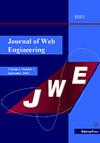Lightweight Test-Time Adaptation for Robust Out-of-Distribution Face Recognition in Web Services
IF 1
4区 计算机科学
Q4 COMPUTER SCIENCE, SOFTWARE ENGINEERING
引用次数: 0
Abstract
Face recognition systems have the potential to support diverse services in Web 3.0 applications, yet two critical challenges remain underexplored. First, existing benchmark datasets are demographically biased and underrepresent elderly East Asian users, limiting fair and inclusive deployment. Second, sensor noise, lighting shifts, and motion blur introduce out-of-distribution (OOD) corruptions that cause severe accuracy degradation and undermine reliability in decentralized environments. To address these issues, we introduce the Korean Senior Face Benchmark, consisting of 700 images of 70 Korean senior celebrities, enabling realistic assessment for an underrepresented demographic. We quantitatively demonstrate that recent state-of-the-art models suffer significant performance drops under realistic corruption conditions, highlighting the need for enhanced robustness. Finally, we show that a lightweight test-time adaptation (TTA) strategy can recover OOD performance without retraining, making it well-suited for edge devices and distributed infrastructures while preserving user privacy. Experiments show accuracy gains of up to 41.5% under the most severe corruptions, along with improvements in intra-class compactness and inter-class separability in the embedding space. The proposed benchmark and adaptation pipeline lay a practical foundation for building distributed, fair, and privacy-aware face-recognition services in Web 3.0 applications.Web服务中鲁棒分布外人脸识别的轻量级测试时间自适应
人脸识别系统有潜力支持Web 3.0应用程序中的各种服务,但仍有两个关键挑战有待探索。首先,现有的基准数据集在人口统计学上存在偏见,对东亚老年用户的代表性不足,限制了公平和包容性的部署。其次,传感器噪声、灯光变化和运动模糊会引入分布外(OOD)损坏,导致严重的精度下降,并破坏分散环境中的可靠性。为了解决这些问题,我们引入了韩国老年人面部基准,由70位韩国老年名人的700张照片组成,为代表性不足的人群提供了现实的评估。我们定量地证明,最新的最先进的模型在现实的腐败条件下遭受显著的性能下降,突出了增强鲁棒性的必要性。最后,我们证明了轻量级测试时间适应(TTA)策略可以在不重新训练的情况下恢复OOD性能,使其非常适合边缘设备和分布式基础设施,同时保护用户隐私。实验表明,在最严重的损坏下,准确率提高了41.5%,同时在嵌入空间中类内紧密性和类间可分性也得到了改善。所提出的基准和自适应管道为在Web 3.0应用中构建分布式、公平和隐私敏感的人脸识别服务奠定了实践基础。
本文章由计算机程序翻译,如有差异,请以英文原文为准。
求助全文
约1分钟内获得全文
求助全文
来源期刊

Journal of Web Engineering
工程技术-计算机:理论方法
CiteScore
1.80
自引率
12.50%
发文量
62
审稿时长
9 months
期刊介绍:
The World Wide Web and its associated technologies have become a major implementation and delivery platform for a large variety of applications, ranging from simple institutional information Web sites to sophisticated supply-chain management systems, financial applications, e-government, distance learning, and entertainment, among others. Such applications, in addition to their intrinsic functionality, also exhibit the more complex behavior of distributed applications.
 求助内容:
求助内容: 应助结果提醒方式:
应助结果提醒方式:


